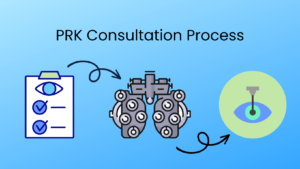PRK Consultation Process

What is PRK?
Photorefractive Keratectomy (PRK), approved in 1995 by the FDA, is a vision correction surgery that can help people see their best without glasses and contacts. PRK Eye Surgery and LASIK are both surgeries that can improve your vision, but PRK might take a little longer to recover from. Talk to your doctor about the specifics before making any decisions! PRK Eye Surgery can help treat nearsightedness (myopia), farsightedness (hyperopia), AND astigmatism – allowing people to have crisp, clear vision.
Who is a Candidate for PRK & LASIK?
Candidates for both PRK Surgery and LASIK are adults 18 years or older who have had stable prescription glasses or contact lenses for at least one year, and who are in good overall health. While both surgeries can help correct astigmatism, nearsightedness, and farsightedness, they work best on those with mild to moderate refractive errors.
In addition to age and health requirements, both types of laser vision correction also require that patients meet certain criteria related to the health of their eyes. The eye surgeon will perform an in-depth evaluation of the patient’s eyes before recommending either type of surgery. This includes checking corneal thickness, tear production quality, prescription, and more.
PRK Surgery may be recommended if you have thin corneas. It may also be recommended if you have had previous eye surgery such as Radial Keratotomy (RK). On the other hand, LASIK Eye Surgery may be recommended if your activities require less downtime following surgery. Your eye doctor can help determine which procedure would best suit your needs after evaluating your eyes thoroughly during an office visit.
At Parkhurst NuVision we have new, updated technologies that can help some of these patients that have been told previously that they were not a candidate for vision correction. For example, SMILE-LASIK and EVO ICL are two procedures that can help people who were not candidates for LASIK Surgery or PRK Surgery in the past. These procedures may help these patients to see better without needing to wear glasses or contacts.
How does PRK correct vision?
PRK Surgery works by using an excimer laser to reshape the cornea, which in turn helps to improve one’s vision. The surgeon removes microscopic amounts of tissue from the surface of the cornea, allowing the laser to complete the vision correction treatment. The PRK treatment allows light rays to focus more accurately on the retina and provides clearer vision. This laser vision correction procedure generally takes about 10 minutes and can be done on both eyes in one visit.
We will explain the procedure to you and administer anesthesia eye drops so that you should not feel eye pain during the surgery. Our laser procedure will remove imperfections in your eyes to help you see clearly, followed by bandage contact lenses that helps protect your eyes as they heal for a few days.
Which one is better: PRK or LASIK?
Refractive Surgery, such as PRK and LASIK Laser Surgery, are both methods that can help improve your eyesight. The main difference is the recovery duration. With LASIK Laser Surgery, you are typically able to return to normal activities the next day, while PRK usually takes around 3-4 days.
When it comes to vision correction, PRK and LASIK are both effective methods for improving eyesight – using a laser to reshape the cornea in order to correct blurred vision!
However, how each procedure is carried out varies slightly; with LASIK, creating a small opening of tissue prior to utilizing its corrective technology while PRK takes those blurry imperfections head-on. No matter what your unique eye anatomy or lifestyle may be – there’s likely to be one which best suits you perfectly!
How is PRK different from LASIK?

PRK surgery involves temporarily removing the quickly regenerating cells from the surface of the cornea, then using a laser to treat the area. Afterward, a bandage contact lens is placed over the eye. LASIK Surgery involves creating a small opening in the cornea so that the surgeon can access the area with the laser to complete the laser vision correction treatment.
PRK recovery timeline
PRK is a type of laser eye surgery that can help improve your vision so you can have less, and usually no more need to wear glasses or contacts. However, it often takes a bit longer to recover from PRK than other types of laser eye surgery, and the recovery process can be more challenging, oftentimes including prescription pain medication for a few days. Some patients may be deterred by the longer vision recovery time, which can take up to three or four months in some cases for sharpest, clearest vision. In contrast, the LASIK procedure requires less time to recover afterward. SMILE-LASIK and EVO ICL are two alternative procedures that provide similar benefits as LASIK Surgery with shorter recovery times.
To reduce the time needed to recover from laser eye surgery, alternatives such as SMILE-LASIK and EVO ICL are available. These options provide LASIK-like outcomes with shorter healing times. If you would like more information about these two options for improving your eyesight, please visit our dedicated pages!
Be sure to talk to one of our doctors about not only the benefits of vision correction, but also any risks of vision correction that may pertain to your individual needs and circumstances.

